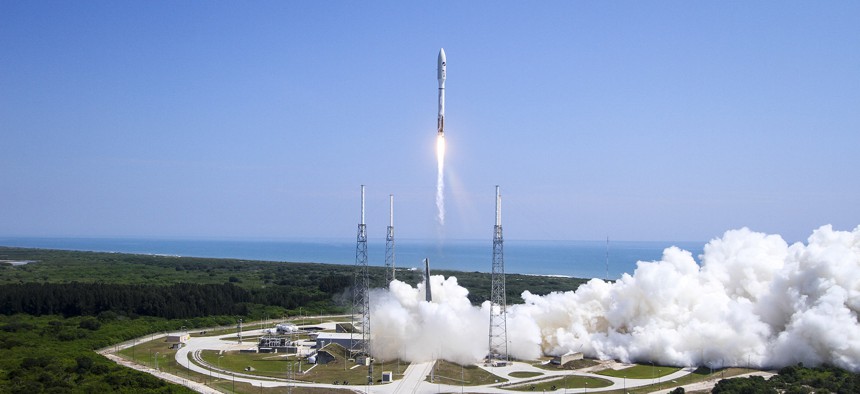
An Atlas V lifts off from Cape Canaveral Air Force Station, Fla. United Launch Alliance
Let the US Air Force Move Ahead with Its Heavy-Lift Rocket Program
Lawmakers' attempt to force the service to allow more companies to bid on satellite launches would do more harm than good.
The U.S. Air Force is on the brink of restoring America’s aeronautical independence by picking two U.S. companies to provide domestic replacements for the Russian RD-180 rocket. A well-intentioned but misguided attempt by the House of Representatives to force the Air Force to allow more companies to bid on an upcoming group of launches would do more harm than good.
Bids are due in August for Phase 2 of the Launch Service Procurement program, which will award contracts to develop rockets that can loft national-security payloads in lieu of the RD-180, which Congress has directed must be phased out of use by 2022. Air Force officials have said they intend to pick just two contractors to split the contracts to launch Pentagon spacecraft between 2022 and 2026. One will receive three-fifths of the launches, the other two-fifths. It is an arrangement that retains variety yet remains manageable.
Some elected officials, however, don’t like the direction they see the LSP heading and are seeking to alter or even delay it. Leading the charge is House Armed Services Chairman Adam Smith, D-Wash., who is principally concerned about the program’s competitive structure. He believes that the LSP must allow more contractors to bid for launch contracts and thus level the playing field. Smith seeks to maintain a balance among the launch providers, not allowing a few to grow too powerful and dominate the others.
Given that the Air Force will soon choose only two firms to receive LSP contracts, this criticism seems fair. After all, generating competition within the aerospace industry can be a path to better, cheaper defense procurement. However, Rep. Smith’s policy proposals wouldn’t accomplish his preferred outcome and would harm national security.
Related: It’s Time to Declare Our Independence from Russian Rockets
Related: Space Is Booming. America’s Next Heavy-Lift Rocket Should Reflect That
Related: If Russia is Selling, the Pentagon Should Keep Buying — Rocket Engines, That Is
To accomplish his goal, the Chairman has been pushing legislation that would alter the LSP program’s structure. The House Armed Services Committee’s version of the 2020 National Defense Authorization Act, approved on July 14, would force the Air Force to lessen competitive standards for launch service providers. The bill would disrupt Phase 2 planning by reopening competition for launch contracts after the first 29 were awarded. This change would substantially decrease the stakes of the Phase 2 selection, creating less incentive for firms to compete at the highest level.
According to the current administration, the decision to limit Phase 2 to just 29 launches would “increase per-launch cost while simultaneously introducing risk and costs for some intelligence payloads.” Essentially, limiting the number of launches would increase the regulatory burden of the project and force the Air Force to spend additional resources adjusting to arbitrary, unnecessary guidelines.
The addendum also would place the Air Force in limbo, unsure how to properly schedule future missions. Col. Robert Bongiovi, director of the Launch Systems Enterprise Directorate at the Space and Missile Systems Center, argued as much: “I don’t know where 29 is going to leave us. If we don’t have a fixed period, we can’t plan for the next transition.” Since the Air Force cannot predict with substantial accuracy when the first 29 launches will be completed, they cannot adequately prepare for the next phase of the program to begin. The change to the LSP would simply create too many confounding variables, adding too much uncertainty to the equation.
Bongiovi similarly argued that the changes would “increase mission risk for the nation’s national security satellites.” That is because the Air Force understands that contracting launch providers is an incredibly complex process. The Air Force must be able to integrate each contractor’s technology into the program safely and properly. A result of Rep. Smith’s preferred changes, satellites would have to be modified to integrate with additional systems and technology. Adding another contractor into the mix means more time wasted, more money spent, and more risk accrued in the process.
The Air Force has continually asserted that a timely progression of the LSP program is essential for securing the nation’s interests in space. More specifically, a delay would force the U.S. to continue its reliance on Russian rockets. According to Bongiovi, a delay “could mean an additional two years” of reliance upon Russian engines. Indeed, stalling the LSP program would impose additional costs on the government and force the Air Force to do more work in less time to meet its legal requirement to phase out RD-180 rockets by 2022. The resulting “crunch time” greatly increases the possibility for error. A greater chance for error creates the potential for more failed launches, more scrubbed missions, and more lost lives.
By rejecting both delays and changes to the LSP program, those tragedies are the very things that the Air Force is attempting to prevent. While Rep. Smith and his compatriots are right to express their concerns about competition within the industry, their proposals wouldn’t quite have the effect they are hoping to achieve. The Air Force’s current plan strikes a balance between protecting America’s national security and advancing innovation within the aerospace industry.
The desire to hold fast to the LSP timetable may seem jarring to those seeking to generate more competition within the industry, but the country is undoubtedly safer for it.



